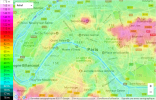Kelly-Leki
A Disturbance in the Force
A: Yes. We have mentioned a 5D city on a hill.
Could it be that the "5D city on a hill" is Paris?
Some remarks, "coincidences", that could be further developed...
1) Paris intra-muros would have 13 hills (generally rendered by the toponymic name "mont " in French (mount)), this figure drops to 5 when we retain the 100 meter limit, which would usually be used to define a hill: these 5 hills are all located on the right bank; moreover, the Sainte-Geneviève mountain (strangely named Montagne whereas it only peaks at 61m) is a hill located on the left bank, it takes up most of the 5th district of Paris and the Latin quarter.
2) Paris, the character of Greek mythology was abandoned as a child on "Mont/Mount" Ida; as an adult, he kidnapped Hèlène and launched the Trojan War which, according to Iman Wilkens, did not take place in what is now Turkey, but in "ancient Egypt" which would appear in northwestern Europe, the original Nile would therefore be the Seine; In addition, Menelaus built a funeral "mound" at the confluence of the Epte and the Seine between Paris and the English Channel: once again, Paris is linked to a "mont/mount/mound";
3) Paris is today the "theatre", the "forum" of the yellow vest demonstrations; however, this movement started with a protest on the rise of oil, this can be correlated by what the Cassiopeans say in this session: "Oil is not enough to explain this. But people will only see the oil cause and turn against the elite for triggering such a disaster.
Today, this movement, this "revolutionary revolt", has broadened its demands towards the elite and could be linked to the prediction read by Arc in the session of 29 December 2009, relating to France, where it is mentioned that "a referendum similar to that of Switzerland will be organised" and which strangely recalls the RIC.
Ps: During this session, it was Rochiana of the Cassiopeans who was present, this first name is very close to the term "Roche/rocher" in French and recalls the idea of "funeral mound" or "tumulus" which when it consists of a pile of stones/rocks is called "Cairn" or "montjoie": another "mont"/mount !
It is interesting to note its etymology where the hill makes an appearance again :) but also the "ancient Egypt":
Wikipedia says:
The word comes from the pre-celtic and Celtic *karn and beyond the proto-Indo-European *kar ("stone, rock").
The Celtic word has given the Scottish word càrn, which has a much broader meaning: it can refer to several types of "hills" as well as natural heaps of stones.
Breton has the word karn3, which is found in toponymy, where there are dolmenic cairns: Carn Island, Pors Carn, Carnac, Carnoët...
Carnac would be the original Karnak... and here again is an allusion to "Ancient Egypt";)
Wipedia says:
Cairns have several functions:
- mark out a path crossing rocky or arid ground, or crossing a glacier;
- identify/spot a particular point such as the top of a mountain or pass, the presence of a cave or some of its accesses or internal passages;
- mark a burial site or celebrate the dead;
- serve as a support for religious practices such as prayer flags in the Himalayas and Tibet.
Would Rochiana and the Cassiopeans "mark out the path" for us so that we could "identify/spot" the "summit of the mountain", the "battle site", the revolution discussed in this session, just like the Trojan War?)
Attachments
Last edited by a moderator:

